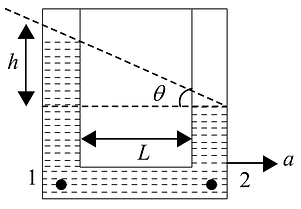A sphere of radius $R$ is gently dropped into liquid of viscosity $ \eta $ in a vertical uniform tube. It attains a terminal velocity $v$. Another sphere of radius $2\,R$ when dropped into the same liquid, will attain its terminal velocity
- v
- 2 v
- 4 v
- 9 v
The Correct Option is C
Solution and Explanation
$\therefore \frac{v'}{v}=\frac{(2 R)^{2}}{(R)^{2}}$
or $v' = 4\,v$
Top Questions on mechanical properties of fluid
If 1000 droplets of water of surface tension 0.07 N/m, having same radius 1 mm each, combine to from a single drop In the process the released surface energy is - (Take π=\(\frac {22}{7}\))
- JEE Main - 2023
- Physics
- mechanical properties of fluid
- As shown in the figure, a liquid is at the same levels in two arms of a U-tube of uniform cross-section when at rest. If the U-tube moves with an acceleration 'f' towards the right,the difference in liquid heights between the two arms of the U-tube will be,(acceleration due to gravity=g)

- WBJEE - 2023
- Physics
- mechanical properties of fluid
- The surface of water in a water tank of cross section area $750\, cm ^2$ on the top of a house is $h m$ above the tap level The speed of water coming out through the tap of cross section area $500 mm ^2$ is $30\, cm / s$ At that instant, $\frac{d h}{d t}$ is $x \times 10^{-3}\, m / s$ The value of $x$ will be ____
- JEE Main - 2023
- Physics
- mechanical properties of fluid
- A Spherical ball of radius $1 \,mm$ and density $10.5\, g / cc$ is dropped in glycerine of coefficient of viscosity $9.8$ poise and density $1.5 \,g / cc$ Viscous force on the ball when it attains constant velocity is $3696 \times 10^{-x} N$. The value of $x$ is_______.
(Given, $g=9.8 \,m / s ^2$ and $\pi=\frac{22}{9}$ )- JEE Main - 2023
- Physics
- mechanical properties of fluid
- A fully loaded boeing aircraft has a mass of $5.4×10^5 $ kg. Its total wing area is $500 m^2$. It is in level flight with a speed of 1080 km/h. If the density of air 𝜌 is $1.2 kg m^{−3}$, the fractional increase in the speed of the air on the upper surface of the wing relative to the lower surface in percentage will be. ($𝑔=10 m/s^2$)
- JEE Main - 2023
- Physics
- mechanical properties of fluid
Questions Asked in JKCET exam
- A moving block having mass $m$, collides with another stationary block having mass $4\,m$. The lighter block comes to rest after collision. When the initial velocity of the lighter block is $v$, then the value of coefficient of restitution (e) will be
- JKCET - 2019
- work, energy and power
- A force $ F = 3x^2 + 2x + 1 $ acts on a body in the $ x $ -direction. The work done by this force during a displacement from $ x = -1 $ to $ +1 $ is
- JKCET - 2019
- work, energy and power
- What is the colour of the flame on heating potassium in the flame of a Bunsen burner?
- JKCET - 2019
- GROUP 1 ELEMENTS
- If $ a $ , $ b $ , $ c $ are the lengths of three edges of unit cell, $ \alpha $ is the angle between side $ b $ and $ c $ , $ \beta $ is the angle between side $ a $ and $ c $ and $ \gamma $ is the angle between side $ a $ and $ b $ , what is the Bravais Lattice dimensions of a tetragonal crystal?
- JKCET - 2019
- The solid state
- Which of the following compounds is known as copper glance?
- JKCET - 2019
- General Principles and Processes of Isolation of Elements
Concepts Used:
Mechanical Properties of Fluid
The science of the mechanical properties of fluids is called Hydrostatics. A fluid is a substance that relents to the slightest pressure. Fluids are categorized into two classes famed by the names of liquids, and elastic fluids or gases, which later comprehend the air of the atmosphere and all the different kinds of air with which chemistry makes us acquainted.
Streamline Flow:
A streamline is a curve the tangent to which at any point provides the direction of the fluid velocity at that point. It is comparable to a line of force in an electric or magnetic field. In steady flow, the pattern of the streamline is motionless or static with time, and therefore, a streamline provides the actual path of a fluid particle.
Tube of Flow:
A tubular region of fluid enclosed by a boundary comprises streamlines is called a tube of flow. Fluid can never cross the boundaries of a tube of flow and therefore, a tube of flow acts as a pipe of the same shape.
Surface Tension and Viscosity:
The surface tension of a liquid is all the time a function of the solid or fluid with which the liquid is in contact. If a value for surface tension is provided in a table for oil, water, mercury, or whatever, and the contacting fluid is unspecified, it is safe to consider that the contacting fluid is air.



